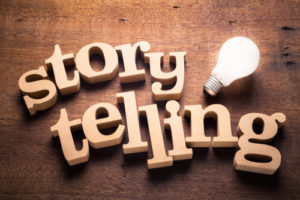 Stories – or anecdotes, examples, case studies – are the absolute best way to illustrate a point, even in a business presentation.
Stories – or anecdotes, examples, case studies – are the absolute best way to illustrate a point, even in a business presentation.
When crafted well, they illustrate and support your messages better than anything else. Stories make an emotional connection to your audience that sticks with them long after you finish talking.
Here are 3 rules of thumb that apply to using stories in your communications:
1. STORIES NEED TO DIRECTLY SUPPORT A POINT. In other words, you may have a favorite story that you love to tell, and that’s great, but it must be constructed in a such a way that it works its way to a “punch line” that reinforces the message point you are trying to support. You can’t assume the audience will make that connection on their own, you have to spell it out and tie it together for them.
2. PREPARATION IS ABSOLUTELY NECESSARY. Rather than simply reminding yourself to tell a certain story during your presentation, you need to map out the story to avoid getting lost in the details while telling it (every story has more details than you have time to share!). I have watched too many speakers derail a perfectly good 15-minute presentation by telling a story that went on and on until – before they knew it – an additional 10 minutes of air time had been consumed.
3. SIMPLE IS MORE EFFECTIVE THAN COMPLICATED. This is true of most communications but certainly true of stories – despite the temptation to “spin a yarn” for your audience. Unless you’re a comedian or a professional storyteller, you’ll want to keep your stories simple.
Keeping them simple means paring down and prioritizing the detail. Think about composing your stories in this 3-3-3 format:
-
3 sentences describing the situation;
-
3 sentences revealing the dramatic tension (e.g. something unexpected, complications, competing factors); and
-
3 sentences outlining the resolution, which should help you tie back – in that punch line kind of a way – to the point you were illustrating.
And finally, be sure to cue your audience when you’re beginning and ending a story. For those in the audience who might not be paying close attention, you have the opportunity to reignite interest with your own appropriate versions of “Once upon a time” and “The end” – those timeless story cues that signal the open and close of something special.
- New Agey Advice for Nervousness - November 3, 2022
- Your Passion Can Go a Long Way Toward Building Connection - October 10, 2022
- Keep stage fright a private matter while you’re speaking on a public stage! - August 11, 2022



